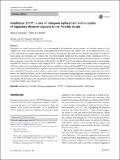Files in this item
Amphioxus SYCP1 : a case of retrogene replacement and co-option of regulatory elements adjacent to the ParaHox cluster
Item metadata
| dc.contributor.author | Garstang, Myles G. | |
| dc.contributor.author | Ferrier, David E. K. | |
| dc.date.accessioned | 2018-01-10T17:30:05Z | |
| dc.date.available | 2018-01-10T17:30:05Z | |
| dc.date.issued | 2018-01 | |
| dc.identifier | 251735763 | |
| dc.identifier | f70c80bb-9f5e-4d4c-a537-637583514364 | |
| dc.identifier | 85039849129 | |
| dc.identifier | 000424445900002 | |
| dc.identifier.citation | Garstang , M G & Ferrier , D E K 2018 , ' Amphioxus SYCP1 : a case of retrogene replacement and co-option of regulatory elements adjacent to the ParaHox cluster ' , Development Genes and Evolution , vol. 228 , no. 1 , pp. 13-30 . https://doi.org/10.1007/s00427-017-0600-9 | en |
| dc.identifier.issn | 0949-944X | |
| dc.identifier.other | ORCID: /0000-0003-3247-6233/work/40266937 | |
| dc.identifier.uri | https://hdl.handle.net/10023/12458 | |
| dc.description | MGG was supported by the University of St Andrews School of Biology Biotechnology and Biological Sciences Research Council DTG and the Wellcome Trust ISSF. Work in the authors’ laboratory is also supported by the Leverhulme Trust. | en |
| dc.description.abstract | Retrogenes are formed when an mRNA is reverse transcribed and re-inserted into the genome in a location unrelated to the original locus. If this retrocopy inserts into a transcriptionally favourable locus and is able to carry out its original function, it can, in rare cases, lead to retrogene replacement. This involves the original, often multi-exonic, parental copy being lost whilst the newer single-exon retrogene copy ‘replaces’ the role of the ancestral parent gene. One example of this is amphioxus SYCP1, a gene that encodes a protein used in synaptonemal complex formation during meiosis, and which offers the opportunity to examine how a retrogene evolves after the retrogene replacement event. SYCP1 genes exist as large multi-exonic genes in most animals. AmphiSYCP1, however, contains a single coding exon of ~3200bp and has inserted next to the ParaHox cluster of amphioxus, whilst the multi-exonic ancestral parental copy has been lost. Here, we show that AmphiSYCP1 has not only replaced its parental copy, but has evolved additional regulatory function by co- opting a bidirectional promoter from the nearby AmphiCHIC gene. AmphiSYCP1 has also evolved a de novo, multi-exonic 5’untranslated region that displays distinct regulatory states, in the form of two different isoforms, and has evolved novel expression patterns during amphioxus embryogenesis in addition to its ancestral role in meiosis. Absence of ParaHox-like expression of AmphiSYCP1, despite its proximity to the ParaHox cluster, also suggests this gene is not influenced by any potential pan-cluster regulatory mechanisms, which are seemingly restricted to only the ParaHox genes themselves. | |
| dc.format.extent | 18 | |
| dc.format.extent | 4542392 | |
| dc.language.iso | eng | |
| dc.relation.ispartof | Development Genes and Evolution | en |
| dc.subject | Amphioxus | en |
| dc.subject | ParaHox | en |
| dc.subject | Retrogene replacement | en |
| dc.subject | SYCPI | en |
| dc.subject | Synaptonemal complex | en |
| dc.subject | CHIC genes | en |
| dc.subject | QH301 Biology | en |
| dc.subject | QH426 Genetics | en |
| dc.subject | NDAS | en |
| dc.subject.lcc | QH301 | en |
| dc.subject.lcc | QH426 | en |
| dc.title | Amphioxus SYCP1 : a case of retrogene replacement and co-option of regulatory elements adjacent to the ParaHox cluster | en |
| dc.type | Journal article | en |
| dc.contributor.sponsor | The Wellcome Trust | en |
| dc.contributor.sponsor | The Leverhulme Trust | en |
| dc.contributor.institution | University of St Andrews. School of Biology | en |
| dc.contributor.institution | University of St Andrews. Marine Alliance for Science & Technology Scotland | en |
| dc.contributor.institution | University of St Andrews. Scottish Oceans Institute | en |
| dc.identifier.doi | https://doi.org/10.1007/s00427-017-0600-9 | |
| dc.description.status | Peer reviewed | en |
| dc.identifier.grantnumber | 097831/z/11/z | en |
| dc.identifier.grantnumber | ORPG-5203 | en |
This item appears in the following Collection(s)
Items in the St Andrews Research Repository are protected by copyright, with all rights reserved, unless otherwise indicated.

